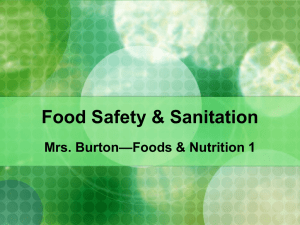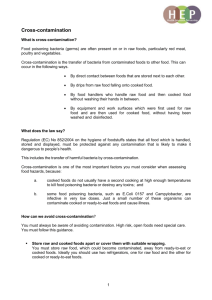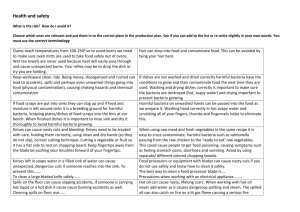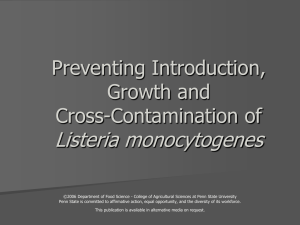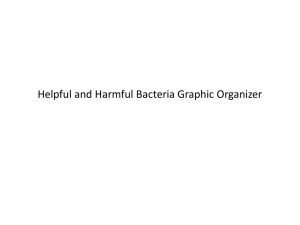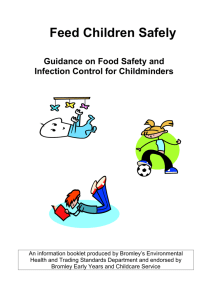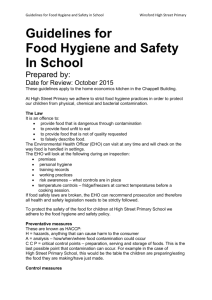guidance notes for restaurant stalls
advertisement
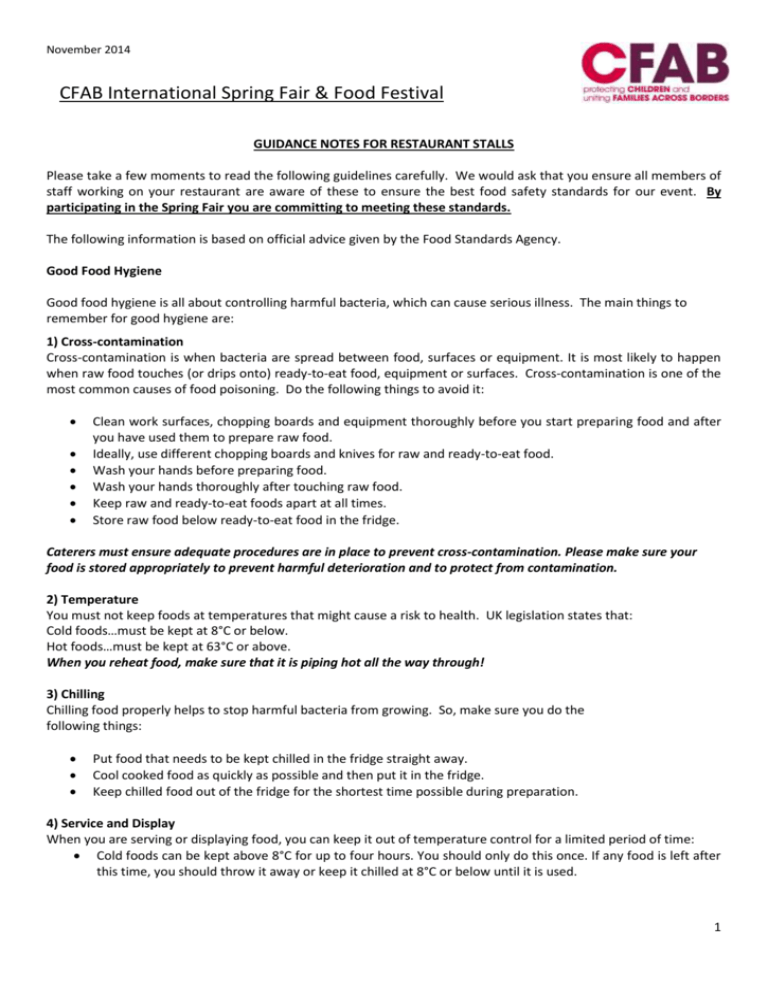
November 2014 CFAB International Spring Fair & Food Festival GUIDANCE NOTES FOR RESTAURANT STALLS Please take a few moments to read the following guidelines carefully. We would ask that you ensure all members of staff working on your restaurant are aware of these to ensure the best food safety standards for our event. By participating in the Spring Fair you are committing to meeting these standards. The following information is based on official advice given by the Food Standards Agency. Good Food Hygiene Good food hygiene is all about controlling harmful bacteria, which can cause serious illness. The main things to remember for good hygiene are: 1) Cross-contamination Cross-contamination is when bacteria are spread between food, surfaces or equipment. It is most likely to happen when raw food touches (or drips onto) ready-to-eat food, equipment or surfaces. Cross-contamination is one of the most common causes of food poisoning. Do the following things to avoid it: Clean work surfaces, chopping boards and equipment thoroughly before you start preparing food and after you have used them to prepare raw food. Ideally, use different chopping boards and knives for raw and ready-to-eat food. Wash your hands before preparing food. Wash your hands thoroughly after touching raw food. Keep raw and ready-to-eat foods apart at all times. Store raw food below ready-to-eat food in the fridge. Caterers must ensure adequate procedures are in place to prevent cross-contamination. Please make sure your food is stored appropriately to prevent harmful deterioration and to protect from contamination. 2) Temperature You must not keep foods at temperatures that might cause a risk to health. UK legislation states that: Cold foods…must be kept at 8°C or below. Hot foods…must be kept at 63°C or above. When you reheat food, make sure that it is piping hot all the way through! 3) Chilling Chilling food properly helps to stop harmful bacteria from growing. So, make sure you do the following things: Put food that needs to be kept chilled in the fridge straight away. Cool cooked food as quickly as possible and then put it in the fridge. Keep chilled food out of the fridge for the shortest time possible during preparation. 4) Service and Display When you are serving or displaying food, you can keep it out of temperature control for a limited period of time: Cold foods can be kept above 8°C for up to four hours. You should only do this once. If any food is left after this time, you should throw it away or keep it chilled at 8°C or below until it is used. 1 November 2014 Hot foods can be kept below 63°C for up to two hours. You should only do this once. If any food is left after this time, you should throw it away, reheat it to 63°C or above, or cool it as quickly as possible to 8°C or below. Please note that food left over on Tuesday should not be re-heated on Wednesday. 5) Cleaning Effective cleaning gets rid of bacteria on hands, equipment and surfaces and therefore helps to stop harmful bacteria from spreading onto food. You should do the following things: Make sure that all your staff wash and dry their hands thoroughly before handling food. Clean food areas and equipment between different tasks, especially after handling raw food. Clear and clean as you go. Clear away used equipment, spilt food etc. as you work and clean work surfaces thoroughly. 6) Personal Hygiene Every person working in a food-handling area must maintain a high level of personal cleanliness. He or she must wear suitable, clean clothing and, where necessary, protective clothing. Staff should keep hair tied back and wear a suitable head covering, e.g. hat or hairnet, when preparing food. Staff should not wear watches or jewellery when preparing food (except a wedding band). Staff should not touch their face and hair, smoke, spit, sneeze, eat or chew gum when they are handling food. 7) Fitness for Work You must not allow anyone to handle food or enter a food handling area if they: are suffering from, or carrying, a disease likely to be transmitted through food have infected wounds, skin infections, sores Have been suffering from diarrhea and/ or vomiting within the last 48 hours 8) Cooking Thorough cooking kills harmful bacteria in food so it is extremely important to make sure that food is cooked properly. When cooking or reheating food, always check that it is piping hot all the way through. It is especially important to make sure that you thoroughly cook poultry, rolled joints and products made from minced meat, such as burgers and sausages. This is because there could be bacteria in the middle of these types of products. They should not be served pink or rare and should be piping hot all the way through. Whole cuts of meat (such as steaks) and whole joints of beef and lamb can be served pink/rare as long as they are fully sealed on the outside. 9) Clearing Up Please DO NOT throw oils/fats or any waste down the sinks in the kitchens as these will block. Please use the bins provided to dispose of ALL waste. Please help us to leave the venue as we found it. Thank you for taking the time to read through this & many thanks for helping us to put on such an exciting event! 2
